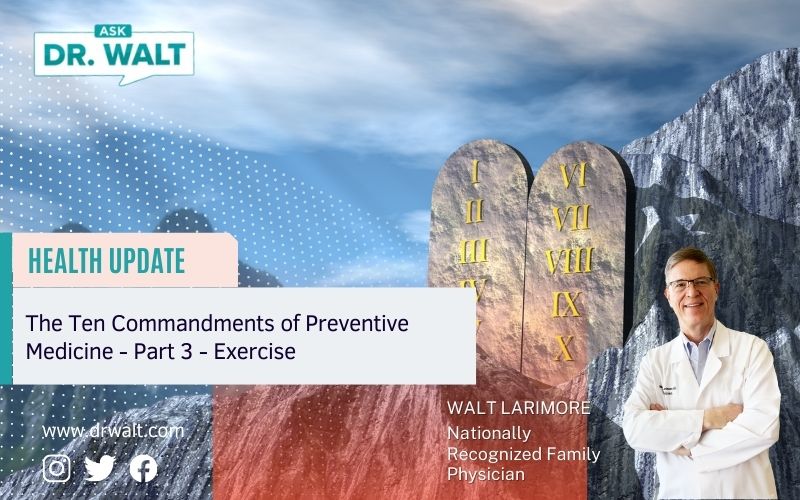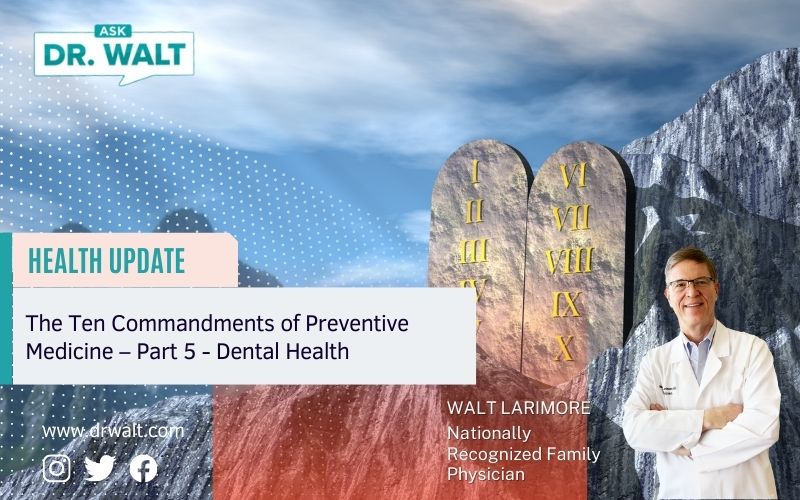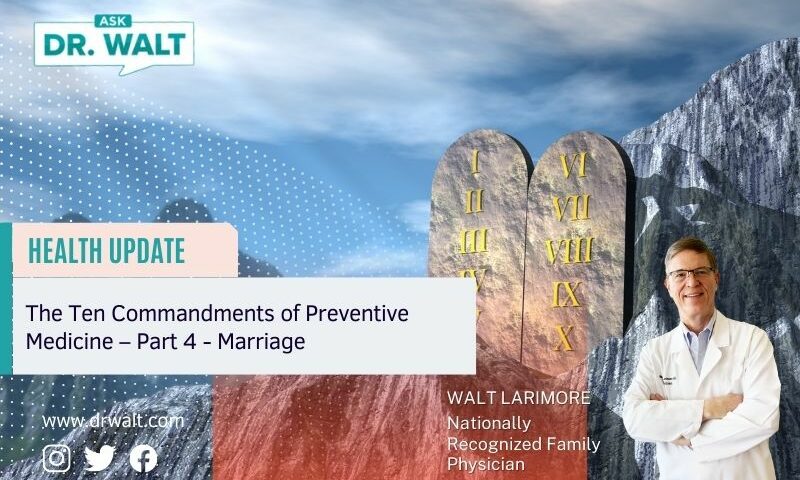
The Ten Commandments of Preventive Medicine – Part 3 – Exercise
January 8, 2023
The Ten Commandments of Preventive Medicine – Part 5 – Dental Health
January 10, 2023In my newest book, 10 Essentials of Happy, Healthy People, I teach people how to utilize ten essentials that are necessary to live a happy and highly healthy life. Under The Essential of Self-Care, teach what I call “The 10 Commandments of Preventive Medicine. Here’s the fourth installment of this ten-part series.
These “Ten Commandments,” which I’ve long suggested to my patients and to my radio and television audiences, target exclusively the physical wheel. I suspect we could identify several more commandments related to preventing disease, but these are an excellent start.
Commandment #4 = Consider the Benefits of a Lifelong Monogamous Marriage Relationship
Married people are, in general, more highly healthy than singles or those who live together without the commitment of marriage. Married people live longer and generally are more emotionally and physically healthy than the unmarried.
That’s the finding of more than 130 studies conducted from the 1930s to the present. Simply put, marriage offers important health benefits to individuals and society that no other relational status can match.
Marriage—to the extent that both the husband and wife are monogamous—can protect a man and a woman from sexually transmitted infections (STIs), which have become epidemic. Every single day, 10,000 teenagers contract an STI—one every 8 seconds—over three million teenagers per year! Of the approximately 15.3 million new cases of STIs that occur annually in the U.S., one in four of the victims is younger than twenty.
STIs accounted for five of the ten most common reportable infectious diseases in this country in the most recent year for which data was available): chlamydia (#1), gonorrhea (#2), AIDS (#3), hepatitis B (#9), and syphilis (#10).
The Centers for Disease Control (CDC) does not collect data on other common sexually transmitted diseases, such as herpes and human papillomavirus (HPV). However, a study published in the New England Journal of Medicineestimated that 20 percent of all Americans age twelve and over are infected with genital herpes.
And HPV is the most prevalent viral STI—having been shown to be present in as many as 60 percent of the sexually active population that has more than one sex partner. HPV causes cancer and precancer of the cervix and is associated with cancer of the penis and prostate.
Once you get one of the STIs caused by a virus, you can have it for life, and STIs, like HPV, can be spread by intimate touching (not just by sexual intercourse)—and can be contracted with the first contact.
That’s why some experts say, “When you have sex with someone, you are instantly having sex with everyone that he or she has ever had sex with.”
Why have sexually transmitted infections become so common? Put simply, it’s because nonmarital sexual activity is epidemic. I’d suggest another possible reason—what I call the “safe sex” myth.
While experts at the CDC tell us that adolescents and adults often don’t use condoms consistently or correctly, one might ask if this is really the answer? The CDC data shows, for example, that only 57 percent of high school students reported using a condom the last time they had intercourse.
What’s more, a 2001 CDC report showed that condoms were proven to be effective only in reducing the risk of HIV/AIDS and gonorrhea in men; for all other STIs, the evidence is insufficient to declare that condoms are effective.
Even when used consistently and correctly, however, both contraceptives and condoms can fail—and even a small failure rate per use will slowly increase the risk of an STI over time. It’s also important to remember that condoms can’t protect sexually active persons from those STIs that are transmitted by skin-to-skin contact (rather than by body fluids). These include genital herpes and HPV.
And condoms never protect the hearts—the emotions and spirits—of people.
When it comes to incurable and potentially fatal viral infections such as AIDS, hepatitis B, and hepatitis C, experts say that the following can reduce your risk:
- Avoid tattoos and body piercing of any kind (except earrings).
- Never use (or allow anyone else to use) a nonsterile needle to inject anything into your body.
- Don’t use illicit drugs. (Snorting cocaine has now been associated with hepatitis C)
- Either abstain from sex or have sex only in marriage and a mutually monogamous lifelong relationship. If you choose to have multiple sex partners (or your partner chooses to do so), then you run a very high risk of contracting a sexually transmitted infection.
Sexual abstinence until marriage and fidelity after marriage clearly reduce your risk for these dangerous forms of preventable—but often untreatable—infections.
The bottom line is that the only “safe sex” physically, emotionally, and spiritually is to wait until marriage—and increasingly our young people are hearing and heeding this message. In 2001, 54 percent of high school seniors were virgins—and the percent continues to increase each year.
You may not find a lot of surprises here—but the real questions are these: Which of these rules do you need to begin to follow? When do you plan to start? What strategies will ensure your success? By beginning with a single step and then continuing to improve on a day-to-day basis, you’ll be on your way to becoming a highly healthy person.
Here are all 10 of the Preventive Medicine Commandments:
- The Ten Commandments of Preventive Medicine – Part 1 – Primary Care
- The Ten Commandments of Preventive Medicine – Part 2 – Obesity
- The Ten Commandments of Preventive Medicine – Part 3 – Exercise
- The Ten Commandments of Preventive Medicine – Part 4 – Marriage
- The Ten Commandments of Preventive Medicine – Part 5 – Dental Health
- The Ten Commandments of Preventive Medicine – Part 6 – Alcohol
- The Ten Commandments of Preventive Medicine – Part 7 – Tobacco
- The Ten Commandments of Preventive Medicine – Part 8 – Alternative Medicine
- The Ten Commandments of Preventive Medicine – Part 9 – Automobile Safety Devices
- The Ten Commandments of Preventive Medicine – Part 10 – Smoke and CO Detectors
And, here are all 10 of the essentials that can be found in my book, 10 Essentials of Happy, Healthy People:
- Set a Wise Balance in Your Life – The Essential of Balance
- Be Proactive in Preventing Disease – The Essential of Self-Care
- Practice Acceptance and Letting Go – The Essential of Forgiveness
- Lighten Your Load – The Essential of Reducing SADness (Stress, Anxiety, and Depression)
- Avoid Loneliness Like the Plague – The Essential of Healthy Relationships
- Cultivate a True Spirituality – The Essential of Spiritual Well-Being
- See Yourself as Your Creator Sees You – The Essential of a Positive Self-Image
- Nurture Your Hopes and Dreams – The Essential of Discovering Your Destiny
- Be Your Own Health Care Quarterback – The Essential of Personal Responsibility and Empowerment
- Team Up with Winning Health Care Providers – The Essential of Teamwork
You can learn more about these in my book, 10 Essentials of Happy, Healthy People. You can order an autographed copy here.



